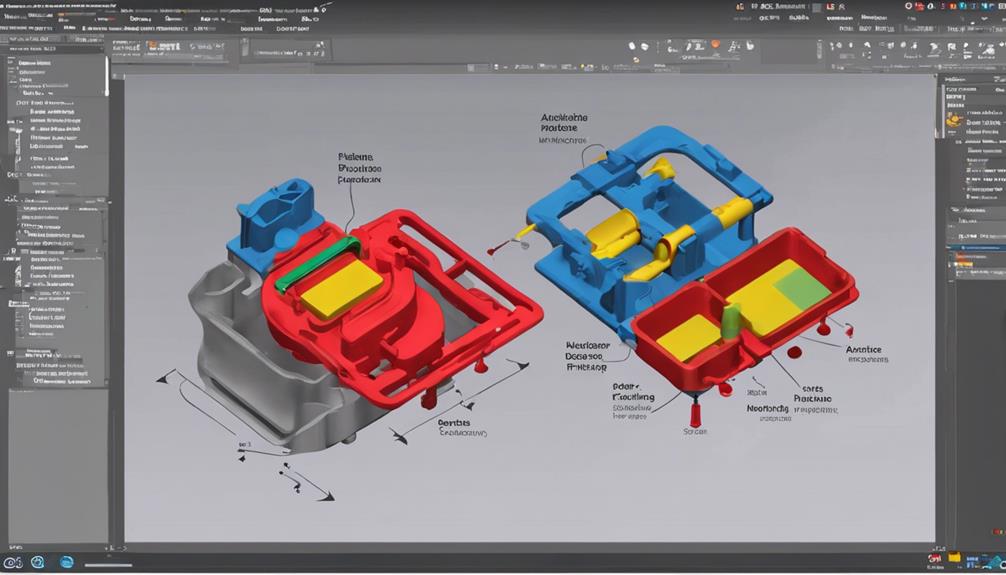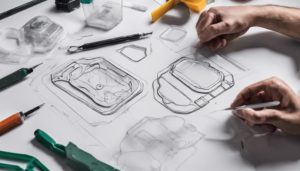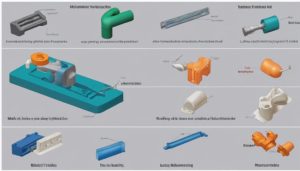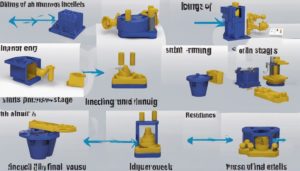Understanding the plastic injection moulding process involves various important aspects such as mould clamping, plastic injection procedure, cooling and solidification stages, part ejection methods, vertical and horizontal moulding features, overmolding, insert molding techniques, volume capacity considerations, press tonnage determination, design compliance, quality control systems, and material selection. These factors play a significant role in achieving precision and efficiency in part production. By mastering these details, manufacturers can guarantee high quality, functionality, and cost-effectiveness in their manufacturing processes.
Mould Clamping Process
The mould clamping process in plastic injection moulding plays an essential role in ensuring the integrity of the mould assembly during the injection cycle. The clamping force required for this process is determined by factors such as the size and complexity of the mould, as well as the material being used. Proper clamping is important as it enables uniform pressure distribution within the mould cavity, resulting in consistent part quality. Different clamping systems, including hydraulic, mechanical, or magnetic systems, are utilized based on specific application requirements.
Accurate mould clamping is necessary to maintain dimensional accuracy in the final product. It prevents any potential shifting or misalignment of the mould halves during the injection process, which could lead to defects in the finished parts. Moreover, precise clamping helps prevent flash formation, which is excess material that escapes between the mould halves. By ensuring a secure and precise clamping process, manufacturers can achieve high-quality plastic parts with the desired dimensional accuracy.
Plastic Injection Procedure
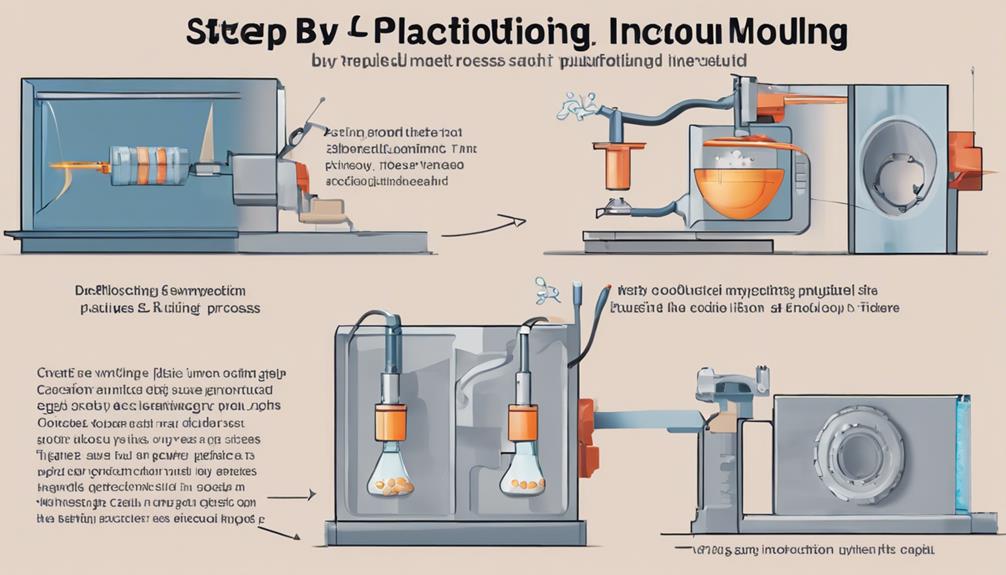
Utilizing high-pressure equipment, the plastic injection procedure initiates the transformation of molten plastic into the desired shape within the mold. The injection phase involves the high-pressure injection of molten plastic into the mold cavity, where it fills and takes on the precise shape of the mold. This process requires precision to make sure that the final product meets the design specifications. The cooling time is vital during injection molding as it allows the molten plastic to solidify and set into the desired shape. Monitoring and controlling the cooling time is essential to prevent defects and guarantee the quality of the final plastic part. The molding stage is where the magic truly happens, as the molten plastic material is shaped and formed into the final product. This step requires expertise and attention to detail to achieve the desired outcome.
| Plastic Injection Procedure | Details |
|---|---|
| Injection | High-pressure process |
| Plastic | Molten material |
| Cooling Time | Vital for solidification |
| Molding | Shapes the final product |
Cooling and Solidification Stage
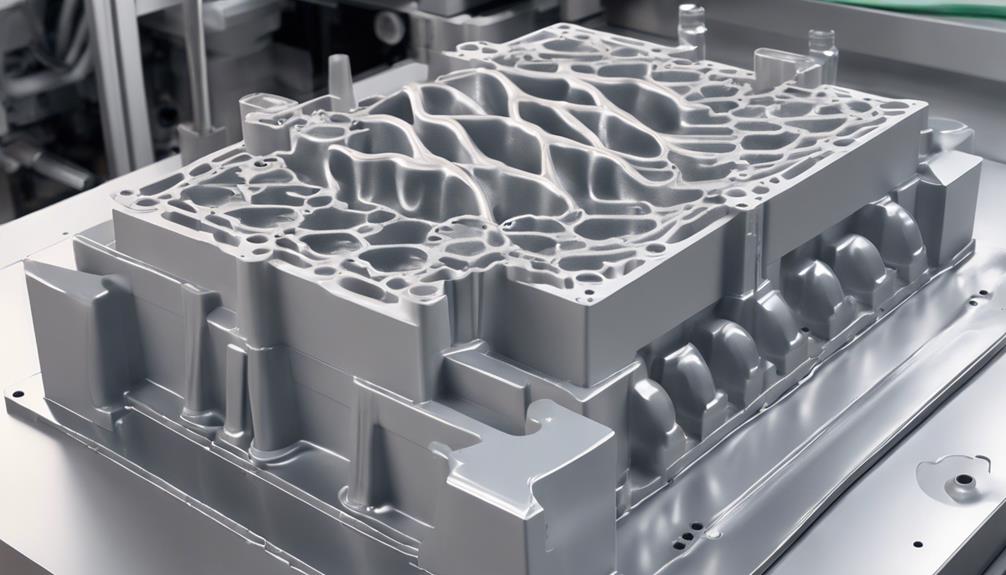
In the cooling and solidification stage of plastic injection molding, the cooling rate plays a critical role in determining the final part's properties. Achieving a uniform solidification of the part is essential to prevent defects such as warping or shrinkage.
The control and optimization of cooling parameters are key factors in producing high-quality plastic components efficiently.
Cooling Rate Importance
Enhancing part quality and dimensional accuracy in plastic injection molding relies heavily on controlling the cooling rate during the solidification stage. The cooling rate plays a critical role in determining the final properties and dimensions of the molded part.
Proper cooling and solidification are essential to avoid defects such as warping, sink marks, and internal stresses. By optimizing the cooling rate, uniform solidification can be achieved, leading to consistent part quality and dimensional accuracy.
Various factors, including mold design, cooling channel layout, material properties, and processing parameters, influence the cooling rate. Optimizing this parameter not only enhances production efficiency and reduces cycle times but also improves the overall quality of parts produced through injection molding.
Uniform Part Solidification
To achieve consistent product quality in plastic injection molding, ensuring uniform part solidification during the cooling and solidification stage is crucial. Proper cooling and solidification stages are essential to guarantee that the plastic material sets uniformly throughout the molded part.
Uniform cooling plays an important role in preventing issues such as warping, stress, and defects in the final product. Maintaining control over the cooling process is paramount for sustaining the dimensional stability and structural integrity of the molded parts.
Advanced cooling strategies and innovative mold designs are instrumental in facilitating efficient and effective part solidification in injection molding processes. Implementing these techniques and approaches contributes significantly to achieving high-quality and uniform final products.
Part Ejection Method
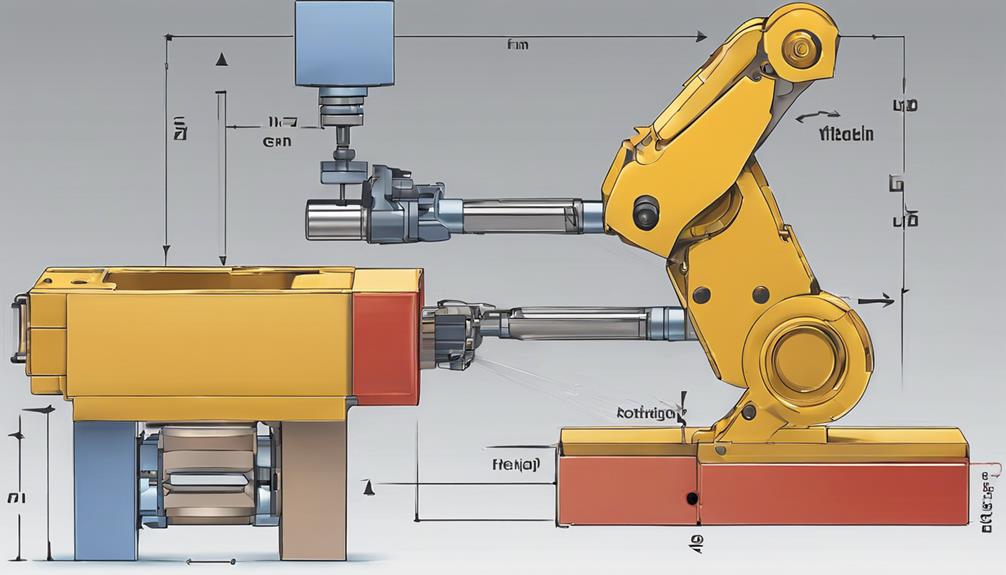
The part ejection process in plastic injection molding involves the removal of the solidified plastic part from the mold using various methods such as ejector pins, air ejection systems, and hydraulic ejection mechanisms.
Ejector pins are commonly employed for simpler parts, while more intricate components may necessitate the use of advanced ejection systems.
The selection of the appropriate ejection method is determined by factors including part complexity, size, material properties, and production specifications.
Ejection Pin Types
Ejection pins in plastic injection molding play an important role in facilitating the efficient ejection of molded parts from the mold. These pins come in various types such as straight, sleeve, blade, and stripper pins, each designed for specific part ejection requirements.
Typically made from hardened steel, these ejection pins are durable to endure repeated use and guarantee effective part ejection. The selection of the appropriate ejection pin type is essential and depends on factors like part geometry, mold design, material type, and production specifications.
Proper design and placement of ejection pins are vital for achieving smooth and consistent part ejection throughout the plastic injection molding process, contributing significantly to the overall efficiency and quality of the manufacturing process.
Air Ejection Systems
In plastic injection molding processes, air ejection systems serve as a pivotal method for efficiently ejecting molded parts from the mold cavity using compressed air. These systems are highly efficient and reliable, ensuring quick and consistent ejection of parts. Here are some key facts about air ejection systems in injection molding:
- Compressed Air Usage: Compressed air is used to push the molded part out of the mold cavity.
- Preventing Damage: Air ejection systems help prevent damage to delicate or intricate parts during the ejection process.
- Cleanroom Applications: They are commonly used in cleanroom injection molding environments to maintain cleanliness and precision.
- Automation and Efficiency: The use of air ejection systems contributes significantly to the overall automation and efficiency of the injection molding process.
Hydraulic Ejection Mechanisms
Utilizing hydraulic pressure as a fundamental mechanism, plastic injection molding employs hydraulic ejection systems to efficiently release molded parts from the mold cavity.
These hydraulic ejection mechanisms function by using hydraulic pressure to actuate ejector pins, plates, or rods, facilitating the seamless removal of parts from the mold during the molding process.
The use of hydraulic ejection ensures consistent and swift part ejection, thereby enhancing the overall production cycle efficiency.
Regular maintenance and calibration of hydraulic ejection systems are essential to uphold their peak performance in plastic injection molding operations.
Vertical Moulding Overview
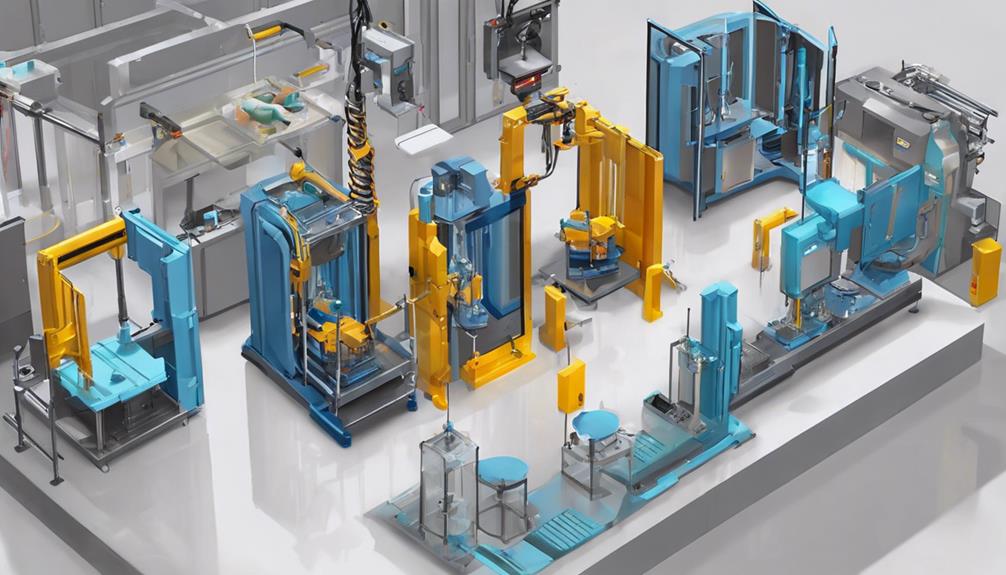
Vertical molding, with its vertically oriented mold and injection unit, is a specialized process known for its efficiency in producing intricate parts suitable for insert molding and overmolding applications. This method offers several advantages, making it a preferred choice in various industries:
- Efficient Part Production: The vertical setup allows for efficient production of intricate and small parts with high precision and consistency.
- Ideal for Insert Molding: Vertical molding is well-suited for insert molding applications where inserts are placed into the mold before the material is injected.
- Overmolding Capabilities: This process is ideal for overmolding, where a substrate is molded over with a different material, commonly used in industries like automotive and electronics.
- Space-saving and Automation Integration: Vertical molding machines offer space-saving benefits and easy integration with automation systems, enhancing manufacturing processes in industries such as medical devices.
Horizontal Moulding Overview
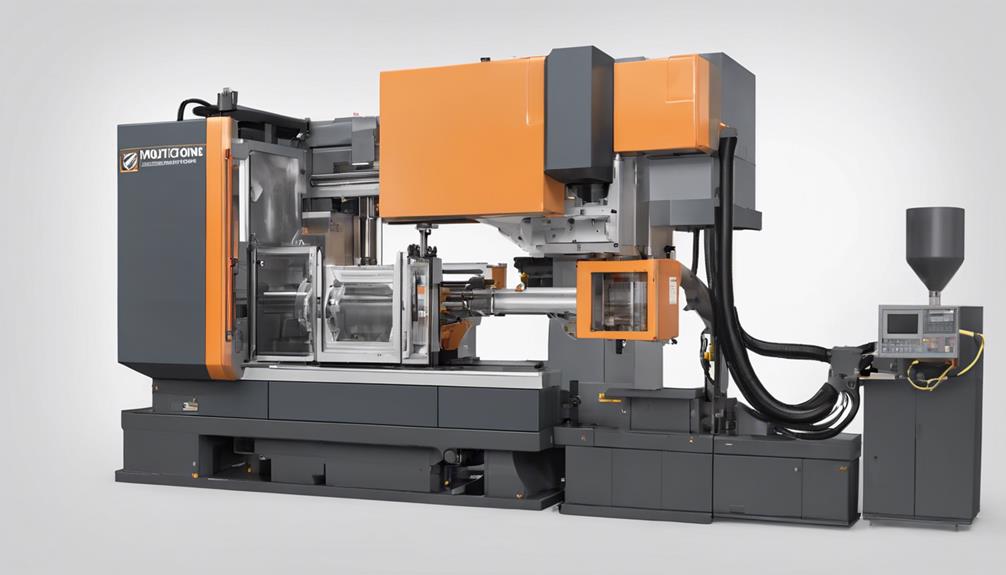
Horizontal moulding offers distinct advantages in the plastic injection moulding process. Key features include the ability to clamp the mould in a horizontal orientation, ideal for parts that require side gating and automation.
The benefits of this method lie in its efficiency for producing larger parts and its suitability for applications requiring multi-cavity moulds.
Key Horizontal Moulding Features
What essential characteristics define the key features of horizontal moulding in plastic injection processes? Horizontal moulding offers efficient production capabilities, precise control over cooling and ejection, and versatility in creating intricate designs.
Key features include:
- Efficient Production: Horizontal moulding machines facilitate high-volume production, making them suitable for various industries.
- Precise Control: This method allows for accurate regulation of cooling rates and ejection processes, ensuring consistent quality.
- Versatility: Horizontal moulding is adept at producing complex shapes and intricate components, meeting diverse design requirements.
- Large Part Production: Ideal for manufacturing larger parts and components, horizontal moulding accommodates specific design needs efficiently.
Benefits of Horizontal Moulding
Maximizing operational efficiency and spatial utilization, horizontal moulding is a fundamental technique in plastic injection processes. This method offers efficient use of space, optimizing floor layout and enabling easier automation integration with auxiliary equipment.
Horizontal moulding is particularly suitable for molding larger parts and accommodating multi-cavity molds. Additionally, it provides better access for mold changes and maintenance procedures, enhancing overall workflow efficiency.
The layout of horizontal moulding machines also offers improved visibility and accessibility during the molding process, allowing for better monitoring and control. These benefits make horizontal moulding a preferred choice for industries looking to streamline their production processes and achieve higher levels of productivity.
Overmolding Techniques
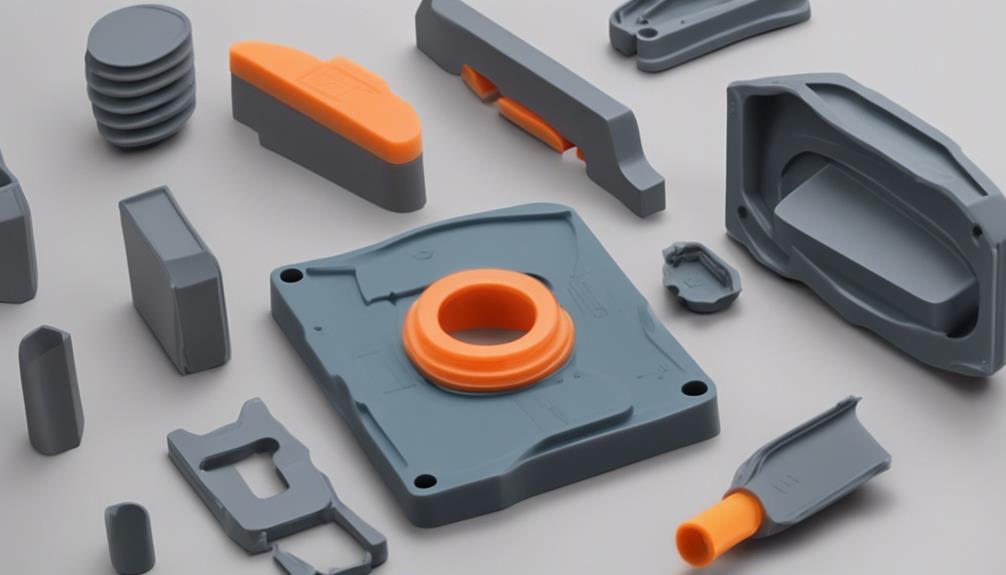
Overmolding techniques in plastic injection molding involve the process of molding one material over another to create a single integrated part with combined properties. This technique offers a range of benefits and applications:
- Materials Combination: Overmolding allows for the combination of different materials, such as soft and hard plastics, to achieve desired properties like flexibility and rigidity in a single part.
- Enhanced Functionality: By incorporating various materials, overmolding enhances product functionality, providing features like improved grip, cushioning, or sealing.
- Aesthetic Appeal: Overmolding enables the creation of visually appealing products with multi-color components or textures, enhancing the overall look and feel.
- Applications: Common applications of overmolding include adding soft grips on tools for ergonomic benefits, creating protective coatings on electronic devices for durability, and producing multi-material components in automotive and consumer goods industries.
This technique not only enhances the design possibilities but also streamlines manufacturing processes by reducing the need for additional assembly steps.
Insert Molding Methods
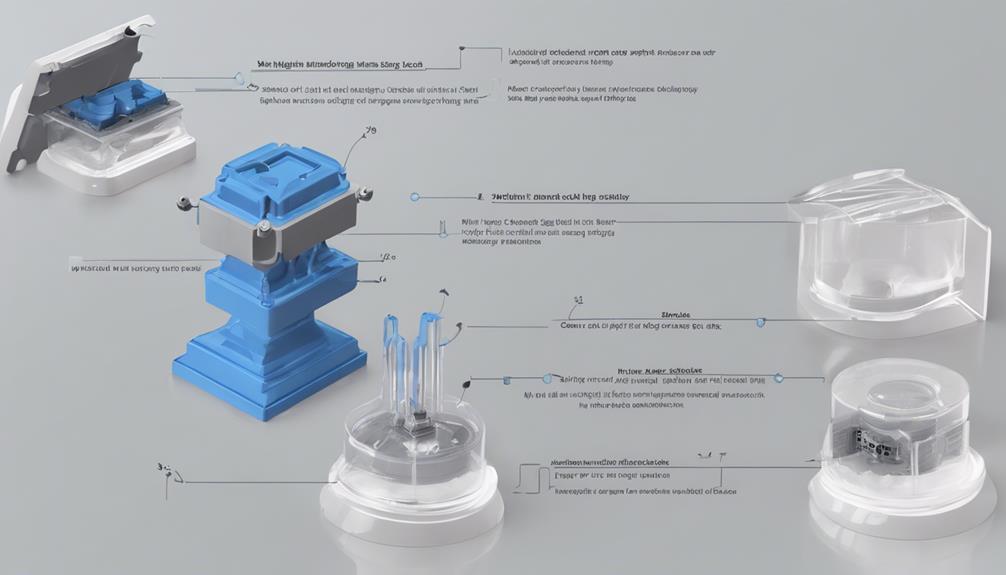
Insert molding methods involve the technique of integrating pre-formed inserts into the plastic injection mold before the plastic material is injected. These pre-formed inserts can be made of various materials like metal, plastic, or other substances, allowing manufacturers to enhance product functionality by combining multiple materials in a single molding process.
This method is commonly utilized in applications where additional features such as threads, bosses, or electrical components need to be incorporated into plastic parts. Insert molding not only enhances the overall strength and durability of the final product but also streamlines the manufacturing process by reducing the need for separate assembly steps.
Part Decoration Options
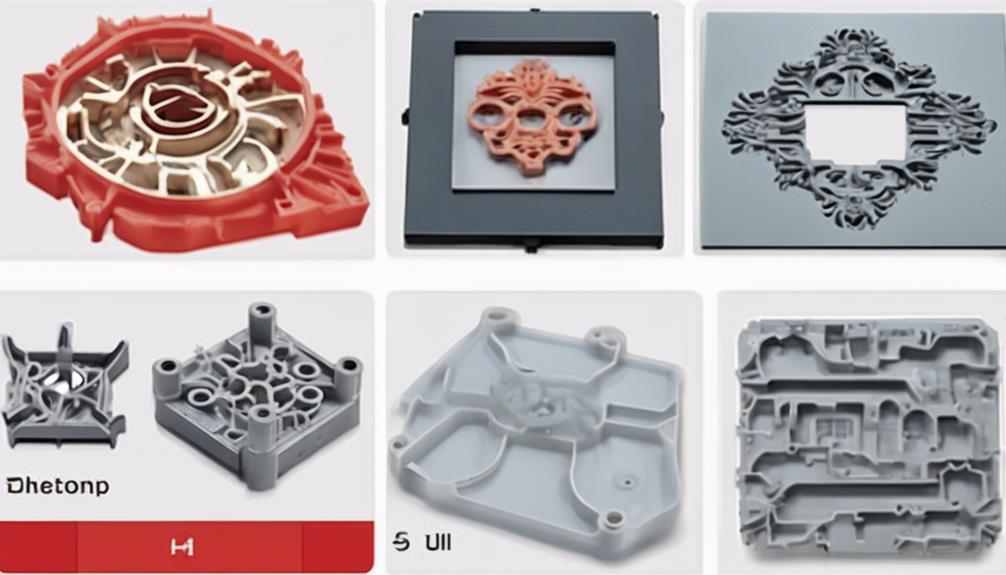
Part decoration options in plastic injection molding are essential for achieving custom color options, intricate printing details, and diverse surface finishing techniques on components.
These techniques, such as painting, printing, or laser etching, allow for the addition of logos, textures, and designs to enhance product aesthetics and branding.
Color Options for Parts
Color options for plastic parts in the injection molding process can be enhanced through various decoration techniques such as painting, printing, and laser etching. Custom color matching services guarantee exact color replication, crucial for branding.
In-mold labeling (IML) and insert molding allow for seamless integration of pre-decorated components into the mold. Different surface finishes like matte, glossy, or textured can be achieved to elevate the visual appeal of plastic parts.
- Painting, Printing, and Laser Etching
- Custom Color Matching Services
- In-Mold Labeling (IML) and Insert Molding
- Different Surface Finishes
Printing on Components
Printing on plastic components in the injection molding process offers a versatile range of part decoration options. These include techniques such as pad printing, hot stamping, and laser engraving.
Pad printing is suitable for intricate designs and small details. On the other hand, hot stamping is ideal for adding metallic finishes to the molded parts. Laser engraving provides precise and permanent marking on plastic components, enhancing both aesthetics and functionality.
These decoration methods allow for the addition of logos, text, or designs to the molded parts for branding or identification purposes. Selecting the appropriate decoration method depends on factors such as design complexity, material compatibility, and the desired finish of the plastic components.
Surface Finishing Techniques
Utilizing surface finishing techniques in plastic injection molding serves to enhance the visual appeal and branding opportunities of the molded components. These techniques, including painting, printing, laser engraving, and hot stamping, offer various options for decorating plastic parts.
Here are some part decoration options that can be achieved through surface finishing techniques:
- Logos: Adding branded logos to the surface of plastic components.
- Textures: Creating textured finishes on the molded parts for a tactile experience.
- Patterns: Applying intricate patterns to enhance the aesthetic appeal of the products.
- Colors: Adding vibrant colors or custom color schemes to make the components visually striking.
Part Assembly Techniques
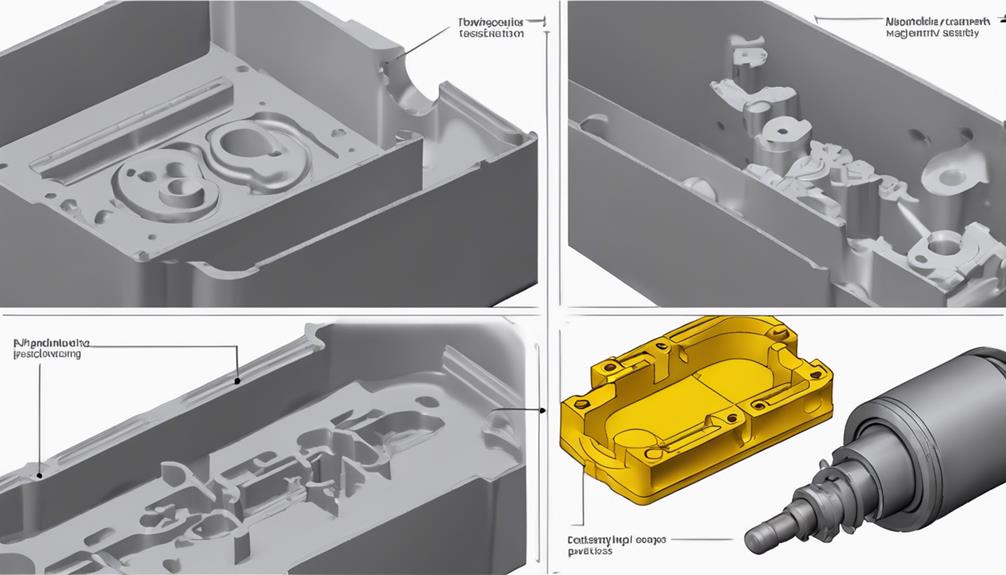
Various part assembly techniques play a crucial role in the plastic injection moulding process, offering efficient and effective ways to join plastic components together.
Ultrasonic welding utilizes high-frequency ultrasonic vibrations to swiftly and effectively bond plastic parts.
Adhesive bonding involves the use of specialized adhesives to create strong and durable connections between plastic components.
Snap-fit assembly is a popular technique where parts are designed with interlocking features that securely snap together, eliminating the necessity for additional fasteners.
Threaded inserts, which are metal inserts integrated into plastic parts during molding, enable the reliable attachment of components using screws or bolts.
Volume Capacity Considerations
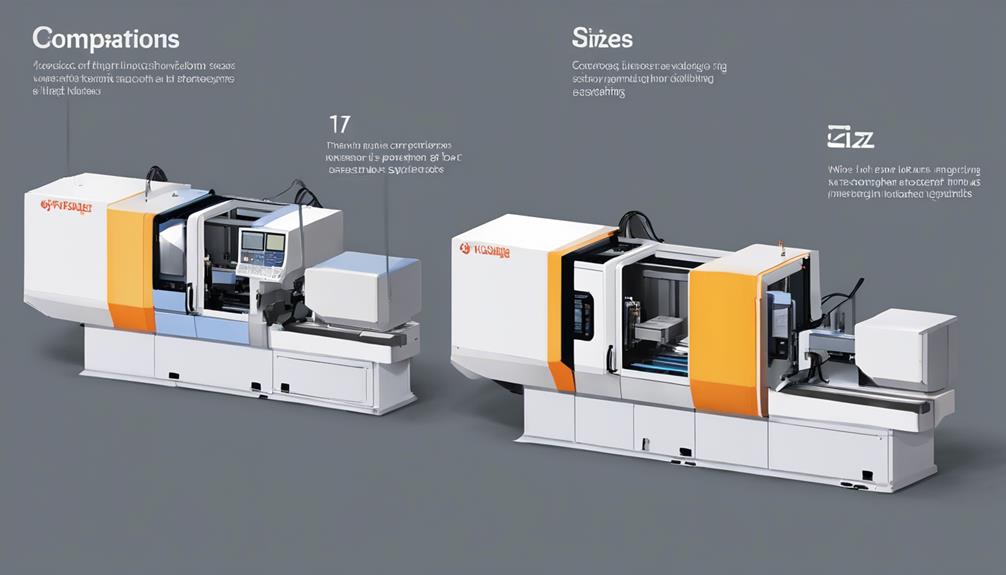
When considering volume capacity in plastic injection molding, optimizing production efficiency for large-scale orders becomes a pivotal factor in meeting production targets while balancing quality requirements.
To guarantee a smooth and efficient production process, several key considerations must be taken into account:
- Machine Capacity: Understanding the capabilities of the injection molding machine is essential for determining the maximum volume of parts that can be produced. Matching the machine capacity with the production requirements is vital for achieving the best results.
- Quality Requirements: Balancing volume capacity with quality requirements is paramount in ensuring that the produced parts meet the specified standards. Striking the right balance between speed and quality is crucial for the success of the injection molding process.
- Efficient Utilization of Resources: Maximizing production output involves efficient utilization of machine time and resources. Proper planning and scheduling can help in optimizing the production process and minimizing downtime.
- Impact on Cost-effectiveness: Volume capacity considerations directly impact the cost-effectiveness and overall turnaround time of injection molding projects. Efficient utilization of resources and streamlined production processes can lead to cost savings and improved project timelines.
Press Tonnage Determination
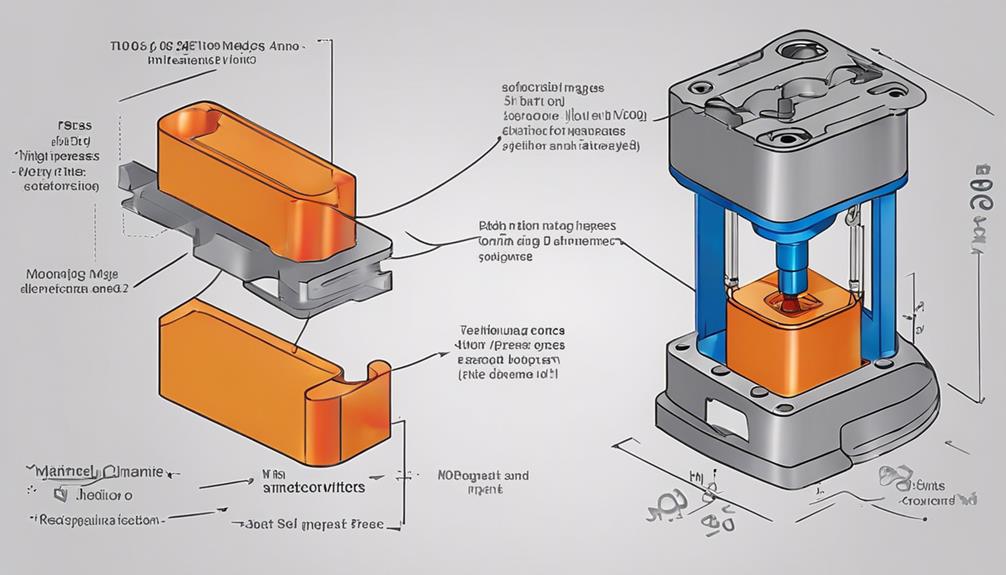
Determining the appropriate press tonnage is a vital aspect of plastic injection molding to ensure the proper clamping force for molds. Press tonnage determination involves calculating the required force based on factors such as the material type, part size, and complexity.
Tonnage calculation is essential as using incorrect tonnage can result in various issues like flash, short shots, or even damage to the mold. Tonnage, typically measured in tons, can range from as low as 5 tons for small parts to over 5000 tons for larger parts.
Proper tonnage selection is paramount in ensuring the production of high-quality, defect-free injection molded parts. By selecting the right press tonnage, manufacturers can achieve optimal mold clamping force, which is essential for the success of the injection molding process.
Careful consideration and calculation of press tonnage are fundamental steps in achieving efficient and effective plastic injection molding operations.
Compliance With Designs
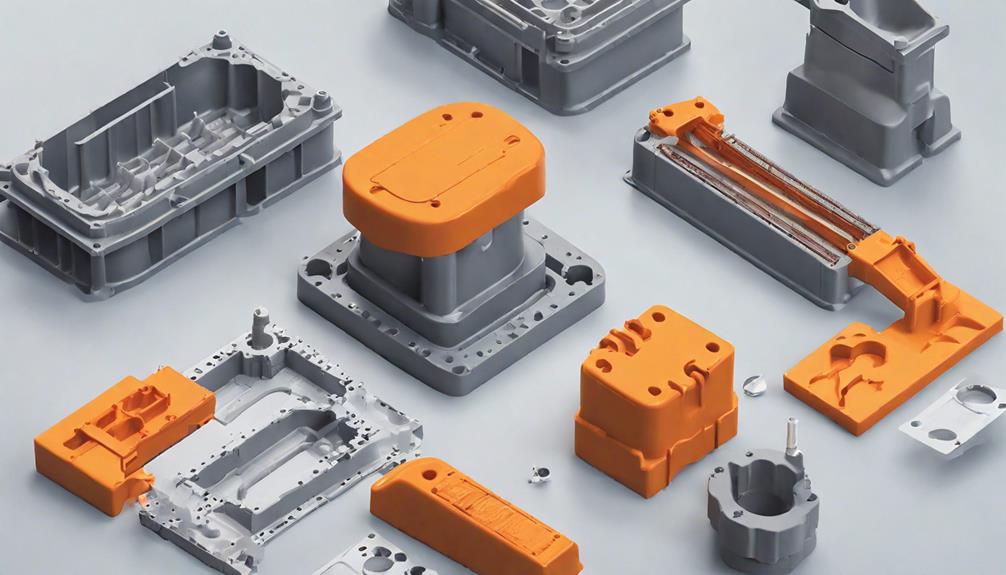
Ensuring meticulous adherence to design specifications is imperative in the plastic injection molding process to guarantee the precise replication of specified dimensions and features in the final molded parts. Compliance with designs plays an essential role in the overall quality and efficiency of the injection molding process.
Here are key points to ponder regarding compliance with designs:
- Precision: Strict adherence to design specifications is essential to guarantee the accurate replication of dimensions and features in the final molded parts.
- Quality Assurance: Compliance with designs helps prevent deviations that could lead to defective parts, maintaining the quality standards of the injection molding process.
- Customer Satisfaction: Meeting design requirements is important for fulfilling customer expectations and ensuring the functionality of the end product.
- Consistency: Precise compliance with designs is necessary to maintain consistency and reliability throughout the injection molding process, enhancing the overall production efficiency and effectiveness.
Quality Control Systems
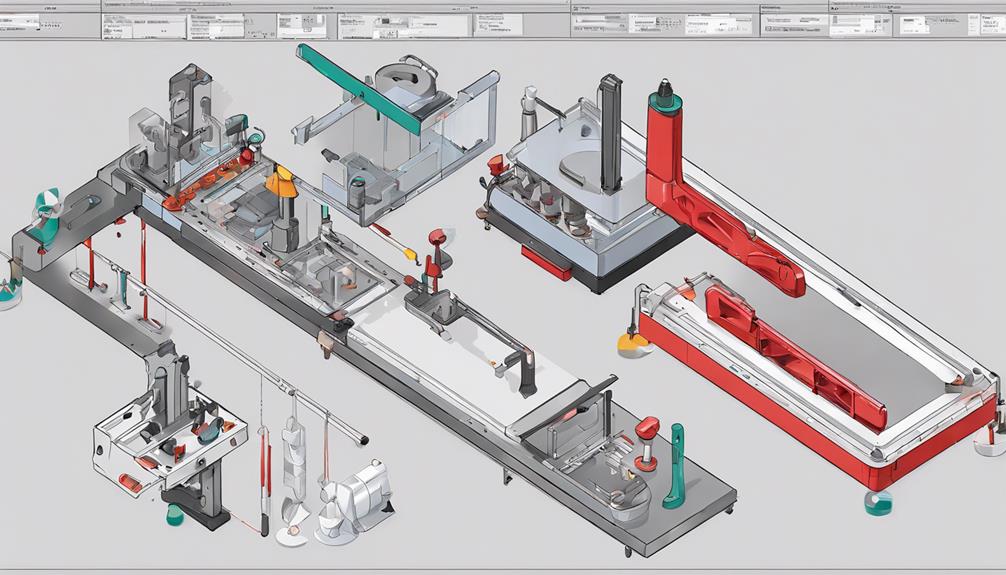
The implementation of rigorous quality control systems is essential in ensuring the consistency and reliability of plastic injection molding production processes. These systems involve meticulous inspection procedures to verify the quality of molded parts. Various quality control measures, such as dimensional checks, visual inspections, and material testing, are carried out to meet industry standards.
By adhering to these quality control protocols, defects are reduced, product quality is improved, and customer satisfaction is enhanced. Quality control in plastic injection molding is vital not only for maintaining consistency but also for meeting specifications, regulations, and customer requirements. It guarantees that the final products meet the desired quality standards and are free from flaws that could compromise their functionality or appearance.
Therefore, a robust quality control system is essential for the success and competitiveness of plastic injection molding operations.
Mold Material and Resin Selection
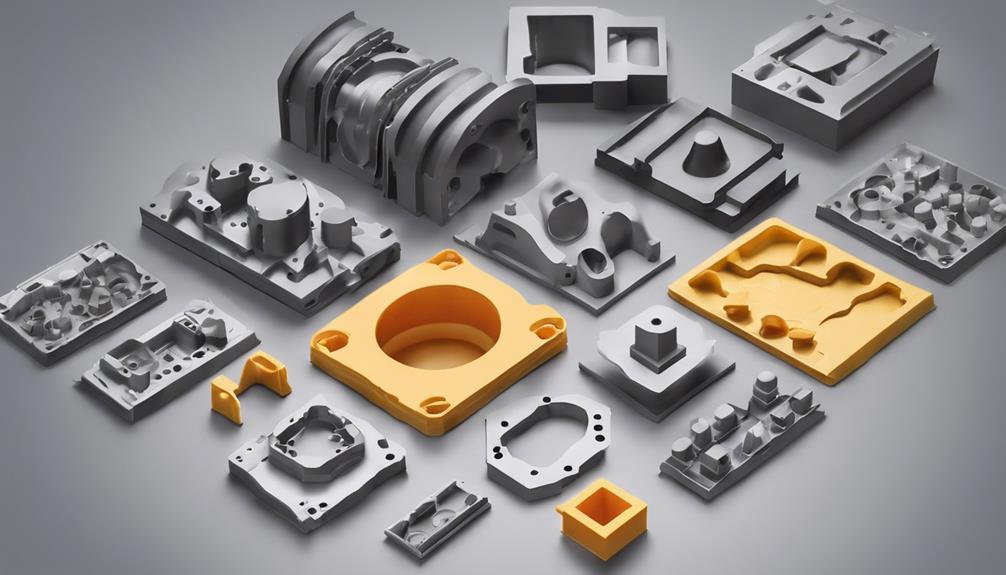
Selection of appropriate mold material and resin types is critical for optimizing the performance and quality of plastic injection molding processes. When contemplating mold material and resin selection, factors such as part properties and production needs play a significant role in determining the success of the manufacturing process.
- Impact of Mold Material: The choice of mold material directly affects the durability of the mold, part quality, and overall production costs.
- Common Mold Materials: Steel, aluminum, and pre-hardened steel are commonly used mold materials, each offering unique benefits that cater to different production requirements.
- Importance of Resin Selection: Resin selection is crucial for achieving desired part properties such as strength, flexibility, and heat resistance, impacting the functionality and performance of the final product.
- Variety of Resins: Resins like ABS, PP, and PC provide diverse characteristics suitable for specific applications, emphasizing the need for proper matching with the chosen mold material to ensure successful plastic injection molding processes.
Frequently Asked Questions
What Is the Injection Molding Process Step by Step?
The injection molding process involves clamping the mold securely, injecting molten plastic under high pressure to shape the mold, and cooling the plastic to solidify the final product.
Ejection of the molded parts occurs after cooling, ensuring the release of the finished part. Monitoring the process for essential manufacturing is vital for quality control and consistency.
This step-by-step method guarantees precise and efficient production of plastic components.
What Is the Sequence of the Injection Molding Process?
The sequence of the injection molding process typically involves:
- Clamping the mold to secure closure
- Injecting molten plastic under high pressure to fill the mold cavity
- Cooling the plastic to solidify and shape it
- Ejecting the finished parts from the mold
Monitoring each step is crucial for ensuring the production of high-quality plastic components.
This sequential process helps in creating precise and reliable plastic parts for various industries.
What Are the Fundamentals of Plastic Injection Molding?
Plastic injection molding fundamentals encompass the precise control of temperature, pressure, and cooling to achieve excellent part quality. Understanding polymer behavior, mold design, and material selection are essential for successful outcomes.
Key aspects include melt flow, gate design, and venting to prevent defects like warping or sink marks. Mastering these fundamentals guarantees efficient production of intricate components with high precision and consistency.
What Are the Key Processes for Injection Molding?
Key processes in injection molding include:
- Clamping: secures the mold
- Injection: fills it with molten plastic
- Holding: allows for solidification
- Cooling: guarantees proper product formation
- Ejection: releases the final product
Each step is essential for efficient and high-quality manufacturing.
Monitoring the entire process guarantees adherence to standards and consistency in production output.
Conclusion
To sum up, the plastic injection moulding process is a complex and precise method of manufacturing plastic parts. One interesting statistic is that the global plastic injection moulding market is expected to reach $162 billion by 2025, with a CAGR of 5.7%. This highlights the increasing demand for plastic injection moulding in various industries worldwide.
It is essential for manufacturers to understand and adhere to the key stages and principles of the process to guarantee efficient production and high-quality end products.
